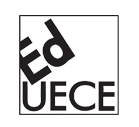The role of authentic texts in the early levels of idiom acquisition
DOI:
https://doi.org/10.46230/2674-8266-15-7772Keywords:
Idioms, Idiom comprehension, Stages of idiom acquisition, ReferencingAbstract
It investigates how authentic texts help children in the early levels of idiom acquisition to understand idiomatic structures, through a theoretical and methodological intersection of Phraseology and Referencing. As a theoretical contribution, we resorted to works by Gibbs (1993), Cacciari (1993), and Vega-Moreno (2003) to discuss some features of idioms, while Levorato (1993) and Vulchanova, Vulchanov and Stankova (2011) served as cornerstones to describe the levels of idiom acquisition. It was decided to resort to works on referencing by Koch (2004), Marcuschi (2005, 2006), Teixeira (2010), and Cavalcante (2011) in order to situate idioms in a pragmatic sphere. Our methodological design evaluates the way in which four seven/eight-year-old children attempt to understand the idiom Deus Grego through the application of semi-structured interviews, carried out in three phases and supported by the reading of the Monica’s Gang comic story (Maurício Araújo de Sousa) entitled Monicão e o Ciumão. The idiom shown in an authentic text allowed the children to mobilize world knowledge and establish meaning relations between verbal and non-verbal text. The results showed that, supported by the comics, children in the early levels of acquisition are highly dependent on context to establish the relationships between idiom and text, apply their prior knowledge in reading, as well as use images as a means to understand idioms.
Downloads
References
ACKERMAN, B. P. On comprehending idioms: Do children get the picture? Journal of Experimental Child Psychology, Florida, v. 33, n. 3, p. 439-454, 1982. DOI: https://doi.org/10.1016/0022-0965(82)90058-3
BIDERMAN, M. T. C. Unidades complexas do Léxico. In: RIO-TORTO, G.; FIGUEIREDO, O. M.; SILVA, F. (Org.). Estudos em homenagem a Mário Vilela. Porto: Faculdade de Letras do Porto, 2005. p. 747-757.
CACCIARI, C.; LEVORATO, M. C. How children understand idioms in discourse. Journal of Child Language, Cambridge, v. 16, n. 2, p. 387-405, 1989. DOI: https://doi.org/10.1017/S0305000900010473
CACCIARI, C. The place of idioms in a literal and metaphorical world. In: CACCIARI, C.; TABOSSI, P. (Org.). Idioms: processing, structure and interpretation. New Jersey: Lawrence Erlbaum, 1993. p. 27-52.
CAIN, K.; TOWSE, A. S.; KNIGHT, R. S. The development of idiom comprehension: an investigation of semantic and contextual processing skills. Journal of Experimental Child Psychology, Amsterdam, v. 102, n. 3, p. 280-298, 2009. DOI: https://doi.org/10.1016/j.jecp.2008.08.001
CAVALCANTE, M. M. Referenciação: sobre coisas ditas e não ditas. Fortaleza: Edições UFC, 2011.
CAVALCANTE, M. M.; CUSTÓDIO FILHO, V.; BRITO, M. A. P. Coerência, referenciação e ensino. São Paulo: Cortez, 2014.
CORTEZ, S. L.; KOCH, I. G. V. A construção do ponto de vista por meio de formas referenciais. In: CAVALCANTE, M. M.; LIMA, S. M. C. (Org.). Referenciação: teoria e prática. São Paulo: Cortez, 2013. p. 9-29.
CORTEZ, S. L. Referenciação e ponto de vista: constituição de instâncias discursivas para a orientação argumentativa na crônica de ficção. In: KOCH, I. G. V.; MORATO, E. M.; BENTES, A. C. (Org.). Referenciação e discurso. São Paulo: Contexto, 2017, p. 319-337.
ETTINGER, S. Alcances e límites da fraseodidáctica. Dez preguntas clave sobre o estado actual da investigación. Cadernos de Fraseoloxía Galega, Santiago de Compostela, v. 10, p. 95-127, 2008.
FONSECA, H. C.; PARREIRA, M. C. Fraseologismos zoônimos do francês-português: da pesquisa ao ensino. In: SILVA, S. (Org.). Fraseologia & Cia. São Paulo: Pontes, 2014, p. 123-140.
GIBBS, R. W. Linguistic factors in children’s understanding of idioms. Journal of Child Language, Cambridge, v. 14, n. 3, p. 569-586, 1987. DOI: https://doi.org/10.1017/S0305000900010291
GIBBS, R. W. Why idioms are not dead metaphors. In: CACCIARI, C.; TABOSSI, P. (Org.) Idioms: processing, structure and interpretation. New Jersey: Lawrence Erlbaum, 1993. p. 57-77.
GIBBS, R. W.; COLSTON, H. L. Psycholinguistic aspects of phraseology: American tradition. In: BURGER, H.; DOBROVOLSKIJ, D.; KUHN, P.; NORRICK, N. (Org.). Phraseologie/phraseology: an international handbook of contemporary research. New York: de Gruyter, 2007. p. 819-836. DOI: https://doi.org/10.1515/9783110190762.819
GLUCKSBERG, S. Idiom meanings and allusional content. In: CACCIARI, C.; TABOSSI, P. (Org.) Idioms: processing, structure and interpretation. New Jersey: Lawrence Erlbaum, 1993. p. 3-26.
KOCH, I. G. V. A coesão textual. São Paulo: Contexto, 1989.
KOCH, I. G. V.; MARCUSCHI, L. A. A. Processos de referenciação na produção discursiva. Delta, São Paulo, v. 14, n. 3, p. 169-190, 1998. DOI: https://doi.org/10.1590/S0102-44501998000300012
KOCH, I. G. V. Linguagem e cognição: a construção e reconstrução de objetos-de-discurso. VEREDAS - Revista de Estudos Linguísticos, Juiz de Fora, v. 6, n. 1, p. 29-42, 2004.
KOCH, I. G. V. Léxico e progressão referencial. In: RIO-TORTO, G.; FIGUEIREDO, O. M.; SILVA, F. (Org.). Estudos em homenagem a Mário Vilela. Porto: Faculdade de Letras do Porto, 2006. p. 263-276.
KOCH. I. G. V.; TRAVAGLIA, L. C. A coerência textual. São Paulo: Contexto, 2015.
KOCH, I. G. V. O texto e a construção dos sentidos. São Paulo: Contexto, 2016.
KOCH, I. G. V. Referenciação e orientação argumentativa. In: KOCH, I. G. V.; MORATO, E. M.; BENTES, A. C. (Org.). Referenciação e discurso. São Paulo: Contexto, 2017, p. 33-52.
LEVORATO, M. C.; CACCIARI, C. Children’s comprehension and production of idioms: the role of context and familiarity. Journal of Child Language, Cambridge, v. 19, n. 2, p. 415-433, 1992. DOI: https://doi.org/10.1017/S0305000900011478
LEVORATO, M. C. The acquisition of idioms and the development of figurative competence. In: CACCIARI, C.; TABOSSI, P. (Org.). Idioms: processing, structure and interpretation. New Jersey: Lawrence Erlbaum, 1993. p. 101-128.
LEVORATO, M. C.; CACCIARI, C. Idiom comprehension in children: are the effects of semantic analysability and context separable? European Journal of Cognitive Psychology, Oxfordshire, v. 11, n. 1, p. 51-66, 1999. DOI: https://doi.org/10.1080/713752299
LEVORATO, M. C.; NESI, B.; CACCIARI, C. Reading comprehension and understanding idiomatic expressions: a developmental study. Brain and Language, Amsterdam, v. 91, n. 3, p. 303-314, 2004. DOI: https://doi.org/10.1016/j.bandl.2004.04.002
LIMA, S. M. C.; FELTES, H. P. M. A construção de referentes no texto/discurso: um processo de múltiplas âncoras. In: CAVALCANTE, M. M.; LIMA, S. M. C. (Org.). Referenciação: teoria e prática. São Paulo: Cortez, 2013. p. 30-58.
MARCUSCHI, L. A. Anáfora indireta: o barco textual e suas âncoras. In: KOCH, I. G. V.; MORATO, E. M.; BENTES, A. C. (Org.). Referenciação e discurso. São Paulo: Contexto, 2005. p. 53-102.
MARCUSCHI, L. A. Referenciação e progressão tópica: aspectos cognitivos e textuais. Caderno de Estudos Linguísticos, Campinas, v. 48, p. 7-22, 2006. DOI: https://doi.org/10.20396/cel.v48i1.8637251
MONDADA, L.; DUBOIS, D. Construção dos objetos de discurso e categorização: uma abordagem dos processos de referenciação. In: CAVALCANTE, M. M.; BIASI-RODRIGUES, B.; CIULLA, A. (Org.). Referenciação. São Paulo: Contexto: 2015, p. 17-52.
MONTEIRO-PLANTIN, R. S. Fraseologia: era uma vez um patinho feio no ensino de língua materna. v. 1. Fortaleza: Edições UFC, 2012.
NIPPOLD, M. A.; MARTIN, S. T. Idiom interpretation in isolation versus context: a developmental study with adolescents. Journal of Speech and Hearing Research, Rockville, v. 32, n. 1, p. 59-66, 1989. DOI: https://doi.org/10.1044/jshr.3201.59
NIPPOLD, M. A.; RUDZINSKI, M. Familiarity and transparency in idiom explanation: a developmental study of children and adolescents. Journal and Speech and Hearing Research, Rockville, v. 36, n. 4, p. 728-737, 1993. DOI: https://doi.org/10.1044/jshr.3604.728
PINHEIRO, C. L. Objeto de discurso e tópico discursivo: sistematizando relações. Linguagem em (Dis)curso, Tubarão, v. 12, n. 3, p. 793-812, 2012. DOI: https://doi.org/10.1590/S1518-76322012000300007
SANTUZ, B. O vei bateu as botas. In: SANTUZ, B. Blog Admita.blog. Rio de Janeiro, 2005. Disponível em: https://bit.ly/2Nj8NyK. Acesso em: 13 nov. 2019.
SILVA NETTO, J. W.; MONTEIRO-PLANTIN, R. S. Processamento referencial das expressões idiomáticas Deus Grego e Deus de Ébano. Intersecções, Jundiaí, v. 11, n. 1, p. 107-125, 2018.
SILVA NETTO, J. W. Análise das estratégias de compreensão idiomática do 1º ao 5º ano escolar. 2020. 286 f. Tese (Doutorado em Linguística) – Centro de Humanidades, Universidade Federal do Ceará, Fortaleza, 2020. Disponível em: http://www.repositorio.ufc.br/handle/riufc/54817. Acesso em: 20 maio 2021.
SIQUEIRA, M.; DUARTE JUNIOR, S.; PEREIRA, L. B.; FERRARI, C. G.; LOPES, N. Compreensão de expressões idiomáticas em período de aquisição da linguagem. Letras de Hoje, Porto Alegre, v. 52, n. 3, p. 391-400, 2017. DOI: https://doi.org/10.15448/1984-7726.2017.3.29371
SIQUEIRA, M.; MARQUES, D. F. Desenvolvimento e validação do instrumento de compreensão de expressões idiomáticas. Revista de Estudos da Linguagem, Belo Horizonte, v. 26, n. 2, p. 571-591, 2018. DOI: https://doi.org/10.17851/2237-2083.26.2.571-591
SOUSA, M. Monicão e o Ciumão. São Paulo: Editora Globo. Disponível em: http://turmadamonica.uol.com.br/historia/monica-monica-e-o-ciumao-2/. Acesso em: 12 maio 2018.
SWINNEY, D. A.; CUTLER; A. The access and processing of idiomatic expressions. Journal of Verbal Learning and Verbal Behavior, Amsterdam, v. 18, n. 5, p. 523-534, 1979. DOI: https://doi.org/10.1016/S0022-5371(79)90284-6
SZYNDLER, A. La fraseología en el aula de E/LE: ¿un reto difícil de alcanzar? Una aproximación a la fraseodidática. Didáctica. Lengua y Literatura, Madrid, v. 27, p. 197-216, 2015. DOI: https://doi.org/10.5209/rev_DIDA.2015.v27.50867
TAGNIN, S. E. O. O jeito que a gente diz: expressões convencionais e idiomáticas. São Paulo: Disal, 2013.
TEIXEIRA, C. S. A referenciação textual numa abordagem cognitiva. Revista do Curso de Letras da UNIABEU, Nilópolis, v. 1, n. 2, p. 129-142, 2010.
TERMIGNONI, S.; FINATTO, M. J. B. Sobre a importância de ensinar expressões idiomáticas. Revista de Italianística, São Paulo, n. 35, p. 112-124, 2017. DOI: https://doi.org/10.11606/issn.2238-8281.v0i35p112-124
VEGA-MORENO, R. E. Relevance Theory and the construction of idiom meaning. UCL Working Papers in Linguistics, Columbus, v. 15, p. 303-323, 2003.
VULCHANOVA, M.; VULCHANOV, V.; STANKOVA, M. Idiom comprehension in the first language: a developmental study. Vigo International Journal of Applied Linguistics, Vigo, n. 8, p. 206-234, 2011.
Published
How to Cite
Issue
Section
License
Copyright (c) 2023 José William da Silva Netto

This work is licensed under a Creative Commons Attribution 4.0 International License.
Authors who publish in Linguagem em Foco Scientific Journal agree to the following terms:
- Authors retain the copyright and grant the journal the right of first publication. The articles are simultaneously licensed under the Creative Commons Attribution License which allows sharing the work with an acknowledgement of its authorship and initial publication in this journal.
- The concepts issued in signed articles are the absolute and exclusive responsibility of their authors. Therefore, we request a Statement of Copyright, which must be submitted with the manuscript as a Supplementary Document.
- Authors are authorized to make the version of the text published in Linguagem em Foco Scientific Journal available in institutional repositories or other academic work distribution platforms (ex. ResearchGate, Academia.edu).





























